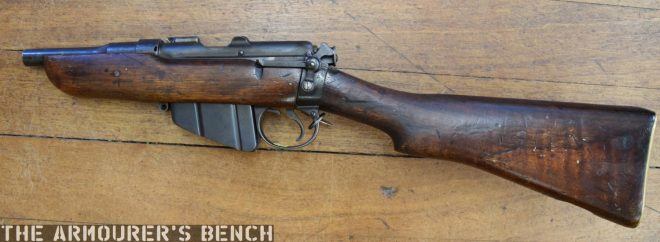No this isn’t an edition of Austin’s Hot Gat or Fudd Crap series and I don’t think it was Bubba which got to this particular Short, Magazine, Lee-Enfield. No, this Obrez SMLE is probably a little more legitimate. I came across this rifle in a UK MoD collection and it was too unusual not to take a look at.
What’s interesting about the concept of an Obrez or cut-down SMLE is the myths that have grown up around them. Were they used during World War One trench raids or by tunnellers digging deep beneath No-Man’s Land? It’s very difficult to confirm the use of cut-down rifles by tunnellers or trench raiding parties. But I thought we’d take a stab at confirming, or busting, the myth around tunneller’s guns.
The British Army began tunnelling on the Western Front in 1915. Tunnelling seemed like the next best option for breaking the stalemate and tunnelling had been used since the medieval period to end sieges. The aim was to lay massive explosive charges beneath enemy strong-points – during the Battle of the Somme, no less than 19 were detonated on the first day of the battle.

Left side of the Obrez SMLE, note the rear volley sight still present (Matthew Moss
But what was it like to be a tunneller? Backbreaking work mixed with ever-present fear and tension and punctuated by vicious underground hand to hand combat. When tunnellers from both sides collided brutal close-quarters fighting followed by the blowing up of the enemy’s tunnel ensued. Tunnellers fought with knives, bayonets, revolvers, shovels and possibly cut-down SMLEs.
The only contemporary reference of using cut-down SMLEs, that I was able to find, comes from a sketch drawn by a tunnelling officer, Major R.S.G. Stokes, who sketched a cut-down SMLE supposedly used by Canadian tunnellers near Ypres. The rifle Stokes drew had a completely exposed barrel and an added front sight post.

Tunneller’s Work Pays Off: The mine under German frontline positions at Hawthorn Redoubt on the first day of the Battle of the Somme, 45,000 pounds of ammonal exploded and the mine caused a crater 130 feet across by 58 feet deep (IWM)
From contemporary descriptions of these subterranean fights they were short, vicious affairs which began with both sides blazing away at one another with pistols before fighting hand to hand. Rather than mention Obrez rifles most accounts describe revolvers and pistols being the primary weapon used. Captain Basil Sawers, of the 177th Tunnelling Company, described using “little automatics which were meant to shoot where your finger pointed.” Captain Matthew Roach of the 255th Tunnelling Company personally carried two revolvers. Another account from Captain William Grant Grieve describes British tunnellers breaking into a German tunnel, “they encountered a party of Germans and immediately opened fire on them with pistols.”
I go into more detail about the history and take a closer look at the rifle in this short video:
This rifle, in particular, has no sights, not a problem for short distances in the confines of a trench or a tunnel, but interestingly, whoever cut the rifle down left the long-range volley peep sight in place. The rifle itself is an SMLE MkI, originally built in 1906. Another interesting feature is the fact it retains its buttstock. Many of the tunnel guns are said to have been cut-down at the barrel and butt.
Firing a cut-down .303 in a confined space would have certainly been an experience for all present combining a mighty report with an impressive muzzle flash the concussion of firing a rifle in a space no more than 5×5′ would have been jarring to say the least – tunnel rats in Vietnam disliked firing .45 ACP M1911A1s in the confined Viet Cong tunnels, let alone a rifle. Sadly it’s impossible to know this particular rifle’s history or provenance but it provided a good opportunity to look at the myth surrounding the Obrez tunneller’s SMLE. Check out more photos here.
 Your Privacy Choices
Your Privacy Choices
